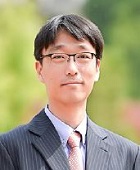
자기차륜을 활용한 이송 장치의 공간 안정성과 제어
Abstract
When the magnetic wheel facing a conductive plate is rotated at high speed, three-axis magnetic forces are generated. Among them, the levitation and lateral forces have self-stability and do not require a separate controller to be stable. In this study, we introduce a device that moves in space by controlling only the transfer position in a transport device comprising four magnetic wheels. The relationship between the design value of individual magnetic wheels and the range of spatial stability is explained using finite element analysis. In particular, the change in the levitation force according to the overlapping distance from the edge of the conductive plate to the center of the magnetic wheel is described using the induced current density. Because the only control variable in the developed system is the wheel speed, we present a simple logic and test results to transfer the system only by controlling the speed.
Keywords:
Electromagnetic analysis, Magnetic levitation, Magnetic wheel, Non-contact transfer, Self stabilityReferences
-
Fujii, N., Ogawa, K., Matsumoto, T., 1996, Revolving Magnet Wheels with Permanent Magnets, Electr. Eng. Jpn., 116:1 106-118.
[https://doi.org/10.1002/eej.4391160110]

-
Jung, K. S., 2013, Non-contact Manipulation of Conductive Rod using Axial Magnet Wheels, J. Inst. Control. Robot. Syst., 19:7 626-632.
[https://doi.org/10.5302/J.ICROS.2013.13.1881]

-
Bird, J., Lipo, T. A., 2008, A 3D Magnetic Charge Finite-element Model of an Electrodynamic Wheel, IEEE Trans. Magn., 44:2 253-265.
[https://doi.org/10.1109/TMAG.2007.911597]

-
Jung, K. S., 2012, A Spatial Stability of the Conductive Rod Conveyed by Double Electrodynamic Wheels, J. Korea Soc. Precis. Eng., 29:8 873-878.
[https://doi.org/10.7736/KSPE.2012.29.8.873]

-
Fujii, N., Ito, Y., Yoshihara, T., 2005, Characteristics of a Moving Magnet Rotator over a Conductive Plate, IEEE Trans. Magn., 41:10 3811-3813.
[https://doi.org/10.1109/TMAG.2005.854930]

- Park, S. J., Jung, K. S., 2011, Design of an Electrodynamic Wheel for Transfer of Conductive rod, J. Korean Soc. Manuf. Technol. Eng., 20:3 251-256.
-
Jung, K. S., 2017, Transfer System using Radial Electrodynamic Wheel over Conductive Track, J. Korea Academia-Industrial Cooperation Soc., 18:11 794-801.
[https://doi.org/10.5762/KAIS.2017.18.11.794]

- ANSYS, n.d., viewed 20 December 2021, Low Frequency EM Field Simulation, <https://www.ansys.com/ko-kr/products/electronics/ansys-maxwell, >.
-
Kang, Y. S., Jung, W. K., Seo, Y. H., Kim, B. H., 2017, On Large Area Aluminum Anodic Oxidation Process using Electric Field Simulation, J. Korean Soc. Manuf. Technol. Eng., 26:6 599-604.
[https://doi.org/10.7735/ksmte.2017.26.6.599]

-
Jung, K. S., Shim, K. B., 2010, Noncontact Conveyance of Conductive Plate using Omni-directional Magnet Wheel, Mechatronics, 20:4 496-502.
[https://doi.org/10.1016/j.mechatronics.2010.04.007]


Professor in the Department of Mechanical Engineering & Robotics Engineering. His research interest is the design and control of mechatronics systems..
E-mail: shlee@andong.ac.kr

Professor in the Department of Mechanical Engineering, Korea National University of Transportation. His research interest includes electromagnetic energy conversion device, magnetic gear, power transmission of electric vehicle, and magnetic levitation application.
E-mail: ksjung@ut.ac.kr